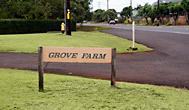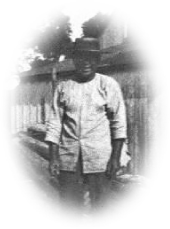Virtual Tour of the Property
Roll over a pin on the map below to learn about that feature’s history and use:
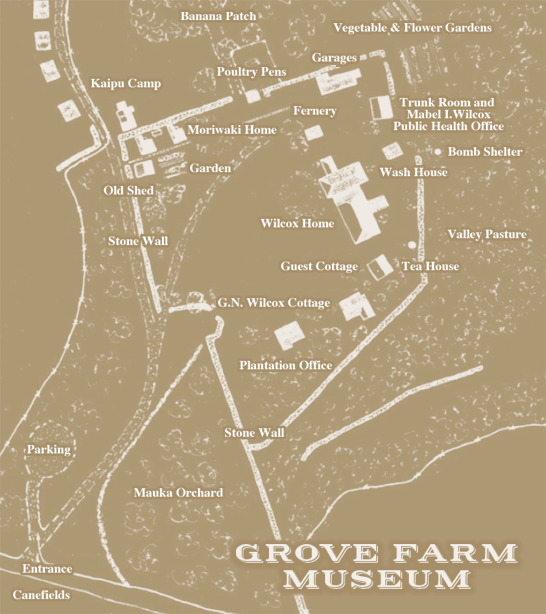
PLANTATION OFFICE
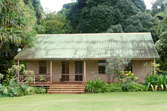 The office where visitors check-in today served as the center of operations for Grove Farm Plantation. It was built ca. 1884 when G. N. Wilcox hired Mr. Purvis as his first bookkeeper. It was also the meeting place of the plantation Board of Directors and of the Kauai Planters Association, as well as accounting operations and employee wage disbursements. It continued as the plantation office until 1935, when the plantation operations were relocted to a new site at Puhi.
The office where visitors check-in today served as the center of operations for Grove Farm Plantation. It was built ca. 1884 when G. N. Wilcox hired Mr. Purvis as his first bookkeeper. It was also the meeting place of the plantation Board of Directors and of the Kauai Planters Association, as well as accounting operations and employee wage disbursements. It continued as the plantation office until 1935, when the plantation operations were relocted to a new site at Puhi.
G.N.’S COTTAGE
 G. N. Wilcox built this two-room cottage for his sleeping quarters about the time the Sam and Emma Wilcox’s daughter Etta was born in l877. Eventually a large bathroom, dressing room and sleeping porch were added. He used it until his death in 1933.
G. N. Wilcox built this two-room cottage for his sleeping quarters about the time the Sam and Emma Wilcox’s daughter Etta was born in l877. Eventually a large bathroom, dressing room and sleeping porch were added. He used it until his death in 1933.
GUEST COTTAGE
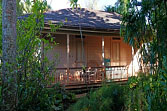 The current structure replaced the original cottage around 1910. During the early years of sugar plantations there were no hotels. True for all the large plantations, the owners and managers homes always included a guest cottage to house guest from outer islands such as dignitaries and clergymen.
The current structure replaced the original cottage around 1910. During the early years of sugar plantations there were no hotels. True for all the large plantations, the owners and managers homes always included a guest cottage to house guest from outer islands such as dignitaries and clergymen.
TEA HOUSE
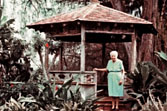 The Japanese garden and tea house were built in 1898 by employee, Mr. Suehiro, who asked permission to do so while the family was away. In 1970, it was the first building restored by Miss Mabel Wilcox (in photo) as part of her developing museum preparations. The restoration retained the original hand carved panels, which include lotus blossoms and Mt. Fuji.
The Japanese garden and tea house were built in 1898 by employee, Mr. Suehiro, who asked permission to do so while the family was away. In 1970, it was the first building restored by Miss Mabel Wilcox (in photo) as part of her developing museum preparations. The restoration retained the original hand carved panels, which include lotus blossoms and Mt. Fuji.
WILCOX HOME
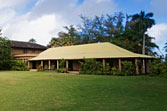 Originally a thatched roof four room house acquired by G.N. Wilcox in 1864, the size of the main house grew as plantation operations expanded. The two story addition and a parlor were added in 1914.
Originally a thatched roof four room house acquired by G.N. Wilcox in 1864, the size of the main house grew as plantation operations expanded. The two story addition and a parlor were added in 1914.
WASH HOUSE
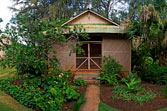 Built ca. 1920’s, this wash house provided fresh clothing and linens for family members at the various houses they enjoyed around the island. This building contains the original wood burning laundry boiler and a wooden linen press. Miss Mabel remembers that as a child the clothes were boiled in old kerosene cans back of the kitchen. The children used to put potatoes in the coals to cook. There was a sort of shed with wash tubs nearby.
Built ca. 1920’s, this wash house provided fresh clothing and linens for family members at the various houses they enjoyed around the island. This building contains the original wood burning laundry boiler and a wooden linen press. Miss Mabel remembers that as a child the clothes were boiled in old kerosene cans back of the kitchen. The children used to put potatoes in the coals to cook. There was a sort of shed with wash tubs nearby.
TRUNK ROOM AND FIRST KAUAI PUBLIC HEALTH OFFICE
 Once a small two-room guest house, this building provided lodging for many visitors. When the Wilcox children were ready for school, it became their schoolhouse and was shared with the younger Rice family neighbors. The older children had received their schooling over at the Rice’s, and then went on to Punahou School. It was enlarged in the 1920’s to provide storage space for family supplies and office space for Miss Mabel’s work in public health nursing and the Tuberculosis Association.
Once a small two-room guest house, this building provided lodging for many visitors. When the Wilcox children were ready for school, it became their schoolhouse and was shared with the younger Rice family neighbors. The older children had received their schooling over at the Rice’s, and then went on to Punahou School. It was enlarged in the 1920’s to provide storage space for family supplies and office space for Miss Mabel’s work in public health nursing and the Tuberculosis Association.
GARAGES
 The three-car garage began as a carriage house, and was later adapted to house automobiles. George Wilcox owned the first automobile on the island and therefore needed also to hire and move a mechanic from the mainland to maintain his new car.
The three-car garage began as a carriage house, and was later adapted to house automobiles. George Wilcox owned the first automobile on the island and therefore needed also to hire and move a mechanic from the mainland to maintain his new car.
MORIWAKI COTTAGE
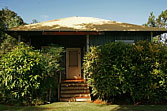 Mrs. Moriwaki (Kikuni) was born on the island of Hawaii, but went to Japan as a baby with her family. She returned to Hawaii as a picture bride. Widowed early in her marriage and with two young sons, Mrs. Moriwaki wrote to G.N Wilcox for a job because she had heard he was a good employer. The Moriwaki Cottage is a testament to her life and other’s that immigrated to Hawaii.
Mrs. Moriwaki (Kikuni) was born on the island of Hawaii, but went to Japan as a baby with her family. She returned to Hawaii as a picture bride. Widowed early in her marriage and with two young sons, Mrs. Moriwaki wrote to G.N Wilcox for a job because she had heard he was a good employer. The Moriwaki Cottage is a testament to her life and other’s that immigrated to Hawaii.
OLD SHED
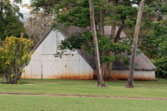 One of the earliest structures on the property, the old shed is typical of a 19th century plantation storage building where the oxen were hitched to ox carts for the start of daily plantation operations. Today the building houses ox yokes and an ox cart, ploughs, an 1899 wooden washing machine, an Apex electric wringer washing machine, and an antique lawn mower, along with other plantation equipment.
One of the earliest structures on the property, the old shed is typical of a 19th century plantation storage building where the oxen were hitched to ox carts for the start of daily plantation operations. Today the building houses ox yokes and an ox cart, ploughs, an 1899 wooden washing machine, an Apex electric wringer washing machine, and an antique lawn mower, along with other plantation equipment.
KAIPU CAMP
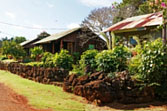 Kaipu Camp originally housed plantation workers for Grove Farm. Today, some of the houses are used for museum operations such as the curator’s office and a plantation records office, but it is also home for some museum employees, keeping the camp alive in its historic nature.
Kaipu Camp originally housed plantation workers for Grove Farm. Today, some of the houses are used for museum operations such as the curator’s office and a plantation records office, but it is also home for some museum employees, keeping the camp alive in its historic nature.
GARDENS, POULTRY PENS AND BANANA PATCH
 As with many farms, self-sustainability played a major role in its operation. It was necessary for plantation owners to raise fruit trees, live-stock and vegetables to supply the family table. The practice continues today, supplying vegetables, fruit and flowers for the household operations.
As with many farms, self-sustainability played a major role in its operation. It was necessary for plantation owners to raise fruit trees, live-stock and vegetables to supply the family table. The practice continues today, supplying vegetables, fruit and flowers for the household operations.
FERNERY
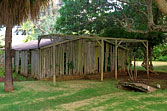 Island ladies of the Victorian era would collect different varieties of maiden hair fern, as well as other fern varieties to use in creating flower arrangements and memorial flower wreaths. This fernery was built for Mrs. Sam Wilcox who was known to have a rare Australian maiden hair fern, which still grows in her fernery today.
Island ladies of the Victorian era would collect different varieties of maiden hair fern, as well as other fern varieties to use in creating flower arrangements and memorial flower wreaths. This fernery was built for Mrs. Sam Wilcox who was known to have a rare Australian maiden hair fern, which still grows in her fernery today.

